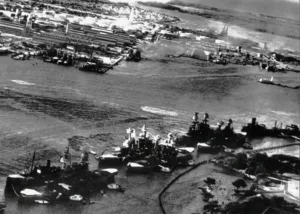December 7, 1941, is a date etched in the annals of history—a day that lives in infamy. On that fateful Sunday morning, the tranquility of the Pacific paradise of Hawaii was shattered as the United States naval base at Pearl Harbor came under a surprise attack by the Imperial Japanese Navy. This unprovoked assault marked a pivotal moment that thrust the United States into World War II and altered the course of global history.
The geopolitical landscape of the 1930s was marred by rising tensions, territorial ambitions, and imperialistic fervor. Japan, seeking to expand its influence in the Pacific, invaded Manchuria in 1931, setting the stage for further aggression. The subsequent invasion of China in 1937 intensified global concerns, leading to condemnation but little concrete action. As Japan continued its expansionist agenda, diplomatic relations with the United States soured, culminating in an oil embargo and the freezing of Japanese assets in 1941.
In the midst of diplomatic wrangling, the Japanese military devised a bold and audacious plan to cripple the Pacific Fleet stationed at Pearl Harbor. Admiral Isoroku Yamamoto, the mastermind behind the plan, sought to eliminate any threat to Japan’s expansion in the Pacific. The plan involved a surprise aerial assault by carrier-based aircraft, targeting key installations and vessels at Pearl Harbor.
At dawn on December 7, 1941, a fleet of Japanese aircraft carriers launched a two-wave attack on Pearl Harbor. The unsuspecting American forces were caught off guard as over 350 aircraft descended upon them. Bombs rained down on battleships, cruisers, and airfields, while torpedo planes targeted the heart of the Pacific Fleet. The chaos and destruction unfolded rapidly, with multiple vessels, including the USS Arizona, succumbing to the onslaught.
The attack on Pearl Harbor resulted in catastrophic consequences for the United States. The Pacific Fleet suffered significant losses, with eight battleships, three cruisers, and four destroyers either sunk or heavily damaged. Aircraft were destroyed on the ground, and the human toll was immens
e, with over 2,400 Americans losing their lives and thousands more injured. The shock and anger reverberated across the nation, prompting President Franklin D. Roosevelt to declare December 7, 1941, “a date which will live in infamy.”
The attack on Pearl Harbor proved to be a turning point in World War II. The United States, previously hesitant to enter the conflict, now found itself fully engaged. Within days, the U.S. declared war on Japan, drawing the nation into a global conflict that would shape the course of history. The attack also solidified the alliance between the United States, the United Kingdom, and the Soviet Union, marking the beginning of the end for the Axis powers.
The immediate aftermath of the attack was
characterize by chaos and a scramble to understand the extent of the damage. President Franklin D. Roosevelt, in a historic address to Congress the following day, declared December 7, 1941, as “a date which will live in infamy” and urged the nation to take up arms in response to this unprovoked aggression. The United States officially entered World War II, aligning itself with the Allied forces against the Axis powers.

The USS Arizona, one of the battleships sunk during the attack, remains submerged at Pearl Harbor to this day. The USS Arizona Memorial, constructed over the sunken battleship, stands as a poignant reminder of the sacrifice and loss endured on that infamous day. The memorial serves as a place of reflection, allowing visitors to pay homage to the servicemen who perished and to contemplate the impact of war on humanity.
Pearl Harbor left an indelible mark on the collective memory of the United States and the world. The attack served as a rallying cry, galvanizing the American spirit and determination to defend freedom and democracy. The phrase “Remember Pearl Harbor” became a national slogan, symbolizing resilience in the face of adversity.
The events of December 7, 1941, continue to be commemorated annually with ceremonies and tributes at Pearl Harbor and across the country. Veterans, historians, and civilians gather to honor the memory of those who lost their lives and to reflect on the enduring lessons of that pivotal moment in history.
The attack on Pearl Harbor had far-reaching consequences for the course of World War II. It prompted the United States to fully commit to the war effort, leading to the mobilization of resources, the drafting of millions of men into military service, and the industrial production necessary to support a global conflict. The collective effort of the Allies, including the United States, eventually turned the tide against the Axis powers, leading to the defeat of Nazi Germany and Imperial Japan.
Seventy-eight years have passed since the skies over Pearl Harbor were darkened by the smoke of destruction, but the memory of that day endures. Pearl Harbor stands as a symbol of sacrifice, resilience, and the unyielding spirit of a nation in the face of adversity. As we remember Pearl Harbor, it is not only a tribute to the past but a commitment to ensuring that the lessons learned from that day continue to shape our shared future.





